气压弹道碎石技术1
- 格式:ppt
- 大小:3.82 MB
- 文档页数:15
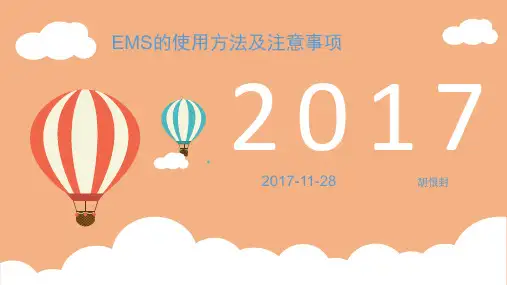
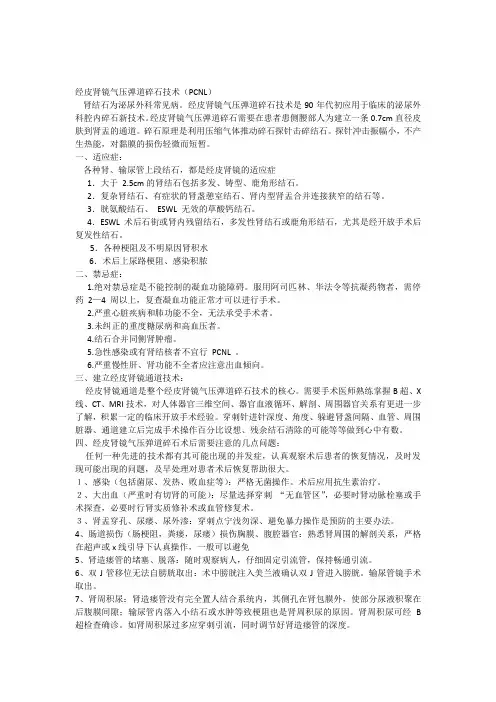
经皮肾镜气压弹道碎石技术(PCNL)肾结石为泌尿外科常见病。
经皮肾镜气压弹道碎石技术是90年代初应用于临床的泌尿外科腔内碎石新技术。
经皮肾镜气压弹道碎石需要在患者患侧腰部人为建立一条0.7cm直径皮肤到肾盂的通道。
碎石原理是利用压缩气体推动碎石探针击碎结石。
探针冲击振幅小,不产生热能,对黏膜的损伤轻微而短暂。
一、适应症:各种肾、输尿管上段结石,都是经皮肾镜的适应症1.大于2.5cm的肾结石包括多发、铸型、鹿角形结石。
2.复杂肾结石、有症状的肾盏憩室结石、肾内型肾盂合并连接狭窄的结石等。
3.胱氨酸结石、ESWL 无效的草酸钙结石。
4.ESWL 术后石街或肾内残留结石,多发性肾结石或鹿角形结石,尤其是经开放手术后复发性结石。
5.各种梗阻及不明原因肾积水6.术后上尿路梗阻、感染积脓二、禁忌症:1.绝对禁忌症是不能控制的凝血功能障碍。
服用阿司匹林、华法令等抗凝药物者,需停药2—4 周以上,复查凝血功能正常才可以进行手术。
2.严重心脏疾病和肺功能不全,无法承受手术者。
3.未纠正的重度糖尿病和高血压者。
4.结石合并同侧肾肿瘤。
5.急性感染或有肾结核者不宜行PCNL 。
6.严重慢性肝、肾功能不全者应注意出血倾向。
三、建立经皮肾镜通道技术:经皮肾镜通道是整个经皮肾镜气压弹道碎石技术的核心。
需要手术医师熟练掌握B超、X 线、CT、MRI技术,对人体器官三维空间、器官血液循环、解剖、周围器官关系有更进一步了解,积累一定的临床开放手术经验。
穿刺针进针深度、角度、躲避肾盏间隔、血管、周围脏器、通道建立后完成手术操作百分比设想、残余结石清除的可能等等做到心中有数。
四、经皮肾镜气压弹道碎石术后需要注意的几点问题:任何一种先进的技术都有其可能出现的并发症,认真观察术后患者的恢复情况,及时发现可能出现的问题,及早处理对患者术后恢复帮助很大。
1、感染(包括菌尿、发热、败血症等):严格无菌操作。
术后应用抗生素治疗。
2、大出血(严重时有切肾的可能):尽量选择穿刺“无血管区”,必要时肾动脉栓塞或手术探查,必要时行肾实质修补术或血管修复术。
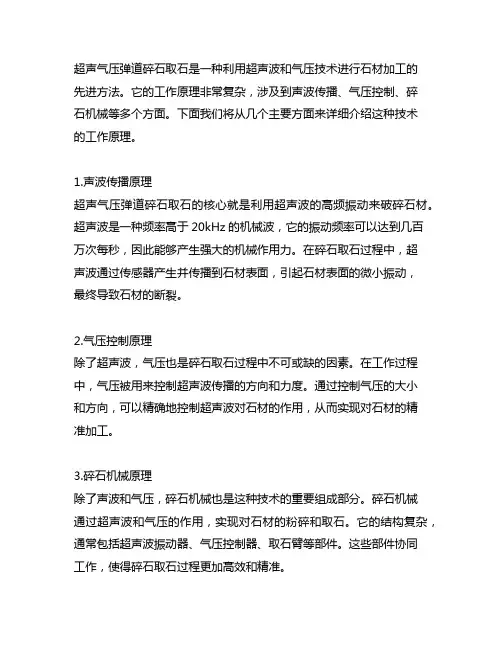
超声气压弹道碎石取石是一种利用超声波和气压技术进行石材加工的先进方法。
它的工作原理非常复杂,涉及到声波传播、气压控制、碎石机械等多个方面。
下面我们将从几个主要方面来详细介绍这种技术的工作原理。
1.声波传播原理超声气压弹道碎石取石的核心就是利用超声波的高频振动来破碎石材。
超声波是一种频率高于20kHz的机械波,它的振动频率可以达到几百万次每秒,因此能够产生强大的机械作用力。
在碎石取石过程中,超声波通过传感器产生并传播到石材表面,引起石材表面的微小振动,最终导致石材的断裂。
2.气压控制原理除了超声波,气压也是碎石取石过程中不可或缺的因素。
在工作过程中,气压被用来控制超声波传播的方向和力度。
通过控制气压的大小和方向,可以精确地控制超声波对石材的作用,从而实现对石材的精准加工。
3.碎石机械原理除了声波和气压,碎石机械也是这种技术的重要组成部分。
碎石机械通过超声波和气压的作用,实现对石材的粉碎和取石。
它的结构复杂,通常包括超声波振动器、气压控制器、取石臂等部件。
这些部件协同工作,使得碎石取石过程更加高效和精准。
4.整体工作原理综合以上几点,《超声气压弹道碎石取石》整体的工作原理可以总结为:通过气压控制器调节气压,并传输到碎石机械中;超声波振动器产生超声波,传递到取石臂上;超声波在取石臂上发挥作用,通过微小的振动使得石材发生破裂;破碎的石材被收集并进行后续加工。
在实际应用中,超声气压弹道碎石取石技术已经被广泛应用于石材开采和加工领域。
它具有加工速度快、精度高和能耗低的优点,受到了行业的广泛好评。
随着科学技术的不断进步,相信这种技术将会在未来得到更加广泛的应用和发展。
超声气压弹道碎石取石技术作为石材加工领域的一项先进技术,不仅在石材开采领域得到了广泛应用,同时也在建筑、雕刻和装饰等领域展现出巨大的市场潜力。
下面我们将进一步探讨该技术的应用及发展前景。
1. 应用领域超声气压弹道碎石取石技术的应用领域非常广泛。
在石材开采领域,这项技术可以极大地提高开采效率和石材质量,减少了开采过程中的浪费和安全隐患。
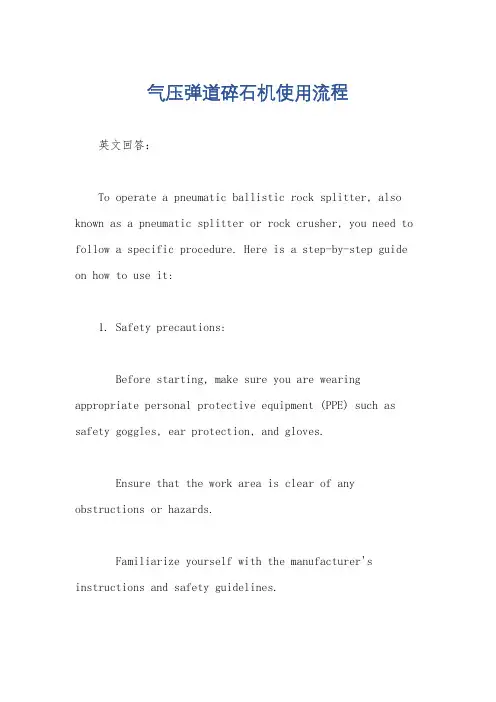
气压弹道碎石机使用流程英文回答:To operate a pneumatic ballistic rock splitter, also known as a pneumatic splitter or rock crusher, you need to follow a specific procedure. Here is a step-by-step guide on how to use it:1. Safety precautions:Before starting, make sure you are wearing appropriate personal protective equipment (PPE) such as safety goggles, ear protection, and gloves.Ensure that the work area is clear of any obstructions or hazards.Familiarize yourself with the manufacturer's instructions and safety guidelines.2. Set up the equipment:Position the pneumatic splitter on a stable surface near the rock or stone you want to break.Connect the air hose to the splitter and the air compressor.Adjust the air pressure on the compressor according to the manufacturer's recommendations.3. Prepare the rock:Inspect the rock for any cracks or weak spots. Avoid using the splitter on rocks that may shatter unpredictably.Clean the surface of the rock to remove any loose debris or dirt.4. Position the splitter:Place the wedge-shaped tip of the splitter againstthe rock's surface at the desired breaking point.Hold the splitter firmly in place, ensuring it is aligned correctly.5. Activate the splitter:Turn on the air compressor to supply compressed air to the splitter.The pneumatic pressure will force the wedge into the rock, creating a crack.The crack will propagate through the rock, splitting it into smaller pieces.6. Monitor the process:Keep an eye on the progress of the splitting operation.Adjust the position of the splitter if necessary toensure the crack follows the desired path.If the crack deviates from the intended path, release the pressure and reposition the splitter.7. Complete the splitting:Once the crack has propagated through the entire rock, turn off the air compressor.Remove the splitter from the rock and inspect the split pieces.Repeat the process if necessary to further break down the rock into desired sizes.Using a pneumatic ballistic rock splitter requires practice and experience to achieve optimal results. It's important to follow the manufacturer's instructions and take the necessary safety precautions to ensure a successful operation.中文回答:使用气压弹道碎石机,也称为气动分裂机或碎石机,需要按照特定的步骤进行操作。
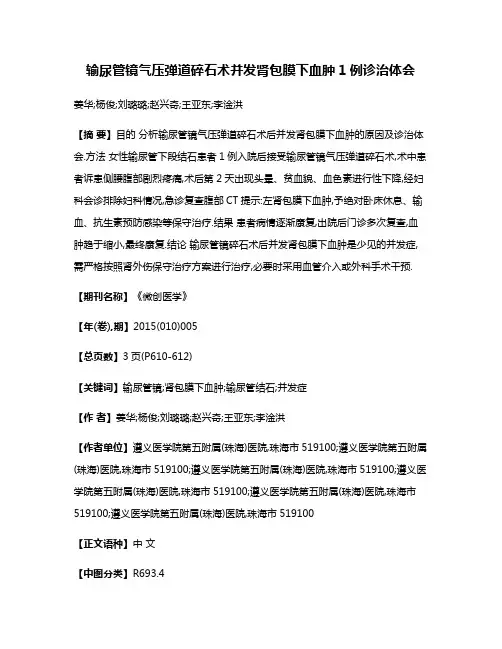
输尿管镜气压弹道碎石术并发肾包膜下血肿1例诊治体会姜华;杨俊;刘璐璐;赵兴奇;王亚东;李淦洪【摘要】目的分析输尿管镜气压弹道碎石术后并发肾包膜下血肿的原因及诊治体会.方法女性输尿管下段结石患者1例入院后接受输尿管镜气压弹道碎石术,术中患者诉患侧腰腹部剧烈疼痛,术后第2天出现头晕、贫血貌、血色素进行性下降,经妇科会诊排除妇科情况,急诊复查腹部CT提示:左肾包膜下血肿,予绝对卧床休息、输血、抗生素预防感染等保守治疗.结果患者病情逐渐康复,出院后门诊多次复查,血肿趋于缩小,最终康复.结论输尿管镜碎石术后并发肾包膜下血肿是少见的并发症,需严格按照肾外伤保守治疗方案进行治疗,必要时采用血管介入或外科手术干预.【期刊名称】《微创医学》【年(卷),期】2015(010)005【总页数】3页(P610-612)【关键词】输尿管镜;肾包膜下血肿;输尿管结石;并发症【作者】姜华;杨俊;刘璐璐;赵兴奇;王亚东;李淦洪【作者单位】遵义医学院第五附属(珠海)医院,珠海市519100;遵义医学院第五附属(珠海)医院,珠海市519100;遵义医学院第五附属(珠海)医院,珠海市519100;遵义医学院第五附属(珠海)医院,珠海市519100;遵义医学院第五附属(珠海)医院,珠海市519100;遵义医学院第五附属(珠海)医院,珠海市519100【正文语种】中文【中图分类】R693.4输尿管镜气压弹道碎石术后并发肾包膜下血肿的发生是非常少见的一种并发症。
我科于2014年9月收治1例女性输尿管下段结石患者,该患者接受输尿管镜气压弹道碎石术,术后第2天出现重度贫血,急诊行腹部CT检查,发现左肾包膜下血肿,经绝对卧床休息、输血、抗生素预防感染等保守治疗,病情逐渐康复。
现报告如下[1]。
1 临床资料患者邱××,女,22岁,因“反复左腰腹部隐痛4月余”入院。
外院B超检查提示:左侧输尿管下段结石,并行体外冲击波碎石术(extracorporeal shock wave lithotripsy,ESWL)治疗6次,治疗无效,遂入我院就医。
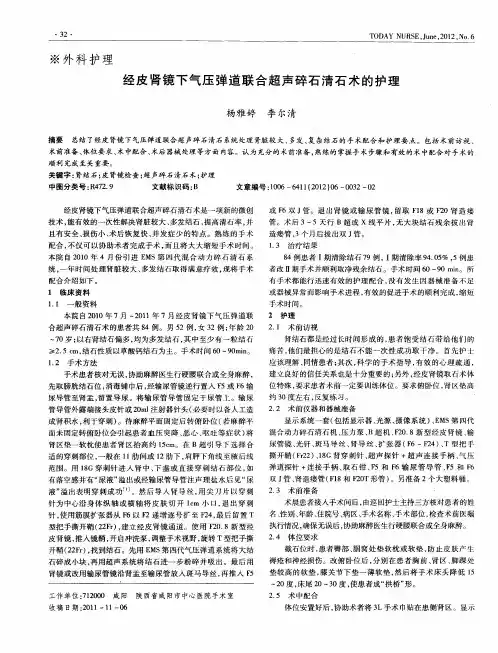
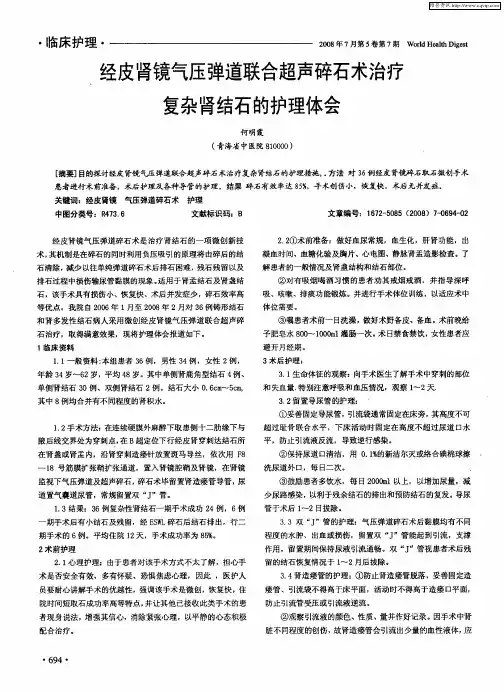
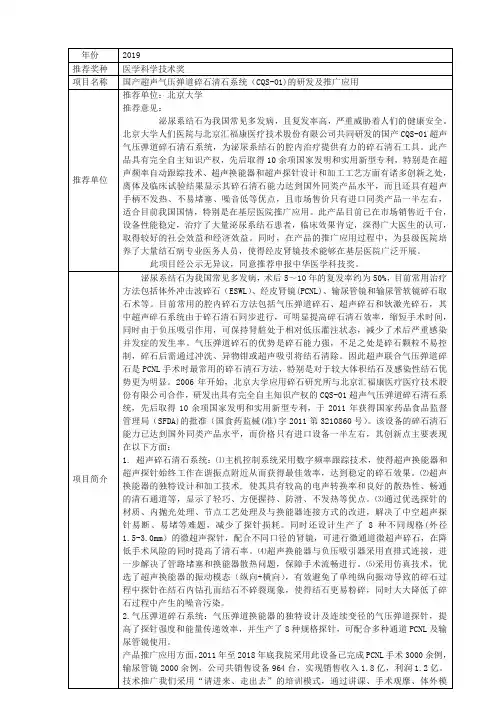

经皮肾镜气压弹道联合超声碎石清石术治疗肾结石的疗效【摘要】目的评价经皮肾镜气压弹道联合超声碎石清石术(PCNL)治疗肾结石的疗效。
方法2007年9月至2009年11月,B超引导下经皮肾镜下气压弹道联合超声碎石清石术治疗1019例肾结石患者。
结果1019例患者均Ⅰ期成功建立经皮肾通道,手术时间20~130 min,平均85 min;结石处理时间16~140 min,平均63 min。
结论经皮肾镜气压弹道联合超声碎石清石术治疗肾结石具有高效、耗时短、安全等特点,值得临床推广应用。
【关键词】肾结石;超声波碎石术;肾镜碎石术2007年9月至2009年11月,治疗1019例肾结石患者,B超引导下经皮肾镜下气压弹道联合超声碎石清石术。
1 资料与方法1.1 一般资料本组1019例,男680例,女339例;年龄16~80岁,平均45.7岁。
单侧肾结石965例,双侧肾结石54例。
肾结石伴肾盂输尿管连接部(uretero-pelvic junction,UPJ)狭窄5例,肾结石为铸形结石645例,多发结石243例,感染肾结石132例,重复肾畸形5例,海绵肾2例,梗阻性脓肾26例,孤立肾结石13例,合并肾功能不全167例;并发肾积水345例。
结石横径0.7~3.4 cm,长径1.8~7.4 cm。
1.2 手术方法采用腰硬联合,取膀胱截石位,膀胱镜下行患侧输尿管用斑马导丝引逆行置平头输尿管导管(F5),留置气囊尿管一并固定,无菌巾包好,改为俯卧位,腹部垫高;尿管导管远端连接生理盐水推注,形成“人工肾积水”。
B超定位通过肾脏的各切面选择目标肾盏,用18G穿刺针在B超引导下穿刺目标肾盏。
确认穿刺针进入肾集合系统后,置入导丝,尖刀开皮,退出穿刺针。
沿导丝使用筋膜扩张器或套叠式金属扩张器逐号扩大至F 18~24,再推入F 16~24不等的剥皮鞘或镜鞘,插入镜芯,观察并寻找结石。
应用灌注泵持续冲洗。
碎石采用瑞士EMS公司的第三代气压弹道联合超声碎石、清石系统,包括合二为一的气压弹道碎石与高效能超声碎石系统及负压吸引系统。
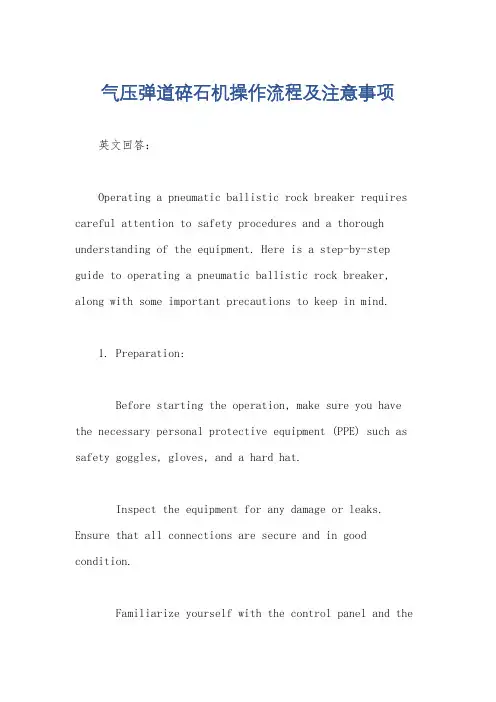
气压弹道碎石机操作流程及注意事项英文回答:Operating a pneumatic ballistic rock breaker requires careful attention to safety procedures and a thorough understanding of the equipment. Here is a step-by-step guide to operating a pneumatic ballistic rock breaker, along with some important precautions to keep in mind.1. Preparation:Before starting the operation, make sure you have the necessary personal protective equipment (PPE) such as safety goggles, gloves, and a hard hat.Inspect the equipment for any damage or leaks. Ensure that all connections are secure and in good condition.Familiarize yourself with the control panel and thedifferent functions of the machine.2. Site Preparation:Clear the work area of any debris or obstacles that may interfere with the operation.Mark the area where you plan to break the rocks to avoid any accidental damage to nearby structures or utilities.Ensure that there are no personnel within the vicinity of the machine during operation.3. Starting the Machine:Check the air compressor to ensure it is properly connected and functioning.Turn on the air compressor and allow it to build up sufficient pressure.Once the desired pressure is reached, turn on the machine's power switch.4. Operating the Machine:Position the machine's nozzle or breaker tool against the rock surface that needs to be broken.Pull the trigger or activate the machine's control lever to initiate the rock-breaking process.Maintain a firm grip on the machine and apply steady pressure to the rock surface.Move the nozzle or breaker tool in a controlled manner to break the rock into smaller pieces.Continue the process until the desired result is achieved.5. Safety Precautions:Always wear the appropriate PPE to protect yourself from flying debris and other hazards.Keep a safe distance from the machine during operation to avoid any potential injury.Never operate the machine in wet or rainy conditions, as it may increase the risk of electrical shock.Regularly inspect the machine for any signs of wearor damage and report any issues to the supervisor.Follow the manufacturer's instructions andguidelines for maintenance and servicing of the machine.Remember, safety should always be the top priority when operating a pneumatic ballistic rock breaker. By following the proper procedures and precautions, you can ensure asafe and efficient operation.中文回答:气压弹道碎石机的操作需要严格遵守安全程序,并对设备有深入的了解。
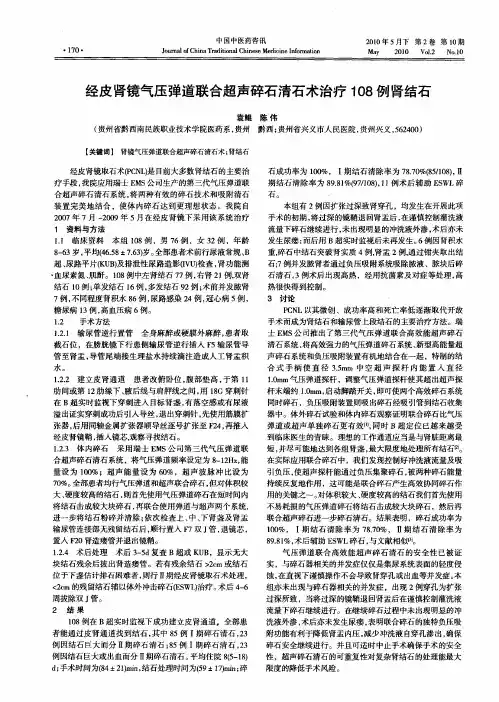
泌尿系结石诊疗指南郑 庆导师:陈戬目录CONTENTS 一背景二碎石器械的分类三诊断四治疗五泌尿系结石分类一背景泌尿系结石是泌尿外科的常见病之一,在泌尿外科住院病人中占居首位。
欧美国家的流行病学资料显示5%~10% 的人在其一生中至少发生1 次泌尿系结石,欧洲泌尿系结石年新发病率约为100~400/10 万人。
我国泌尿系结石发病率为 1%~5% ,南方高达 5%~10%;年新发病率约为 150~200/10 万人,其中 25% 的患者需住院治疗。
近年来,我国泌尿系结石的发病率有增加趋势,是世界上 3 大结石高发区之一。
近年来,随着泌尿系结石病因研究的深入,结石的代谢危险因素越来越为泌尿外科工作者所重视。
体外冲击波碎石术( extracorporeal shock wave lithotrripsy , ESWL)、经皮肾镜取石术(percutaneous nephrolithotripsy , PNL)、输尿管肾镜取石术 (ureterorenoscope lithotripsy , URL)、腹腔镜取石术(laparoscope lithotomy) 的陆续出现,使泌尿系结石的治疗逐渐向微创方向发展。
此外,结石复发的预防工作已经成为了泌尿外科工作者关注的重点。
1.无石率 (SFR) 指同一组结石患者接受治疗后、在特定的阶段内“无石"的患者数与所有研究对象的比率,是评价结石治疗效果的一个主要指标。
"无石" (stone free , SF) 是指 X 线摄片、超声或者 CT 扫描检查无残留结石的证据,即结石排净。
国内外学者主要以首次 SWL 后的 SFR 评价治疗效果,但对效果评估时间(特定阶段)仍存争议。
2.残石的定义尚存争议,可分为临床无意义残石及临床有意义残石两类。
临床无意义残石 (CIRF) 是指治疗后残石直径≤4mm的草酸钙或磷酸钙结石、上尿路解剖正常、无尿路感染或者其他任何症状者,多为完全粉碎的残余结石碎片,可以不继续临床处理;而对于直径≥5mm或者有临床症状的残余结石,即临床有意义结石(SIRF)。
临床论著气压弹道联合超声碎石术和经尿道前列腺汽化电切术治疗良性前列腺增生合并膀胱结石安尼瓦尔牙生 宋光鲁 李建兴① 王玉杰(新疆医科大学第一临床医学院泌尿外科,乌鲁木齐 830054) 【摘要】 目的 探讨前列腺增生合并膀胱结石有效的治疗方法。
方法 采用瑞士E M S 第3代超声/弹道碎石清石系统(L ithoCla stM aster )和经尿道前列腺汽化电切术(transurethral re section of the p rostate,T URP )治疗前列腺增生合并膀胱结石33例。
结果 33例均一次手术成功,碎石时间15~65m in 平均35m in;前列腺电切时间50~110m i n,平均85m in 。
术中术后均无输血,无电切综合征、膀胱穿孔、结石残留等并发症。
术后5d 拔除尿管,无排尿困难、尿失禁等。
病理结果均为良性前列腺增生。
术后3个月,国际前列腺症状评分由(23.4±5.2)分下降至(7.4±1.2)分(t =3.732,P =0.000),最大尿流率由(5.4±1.5)m l/s 升至(18.6±3.2)m l/s(t =2.491,P =0.015),生活质量评分由(3.9±1.2)分降至(2.0±0.7)分(t =2.454,P =0.014)。
结论 瑞士E M S 第3代超声/弹道碎石清石系统和经尿道前列腺汽化电切术能有效治疗良性前列腺增生合并膀胱结石。
【关键词】 前列腺增生症; 膀胱结石; 气压弹道碎石; 经尿道前列腺电切术 中图分类号:R697+.32;R694+.4 文献标识:A 文章编号:1009-6604(2008)04-0323-02PC N L C o m b i n ed w ith TURP for Ben i gn Pr osta t i c Hyper pl a si a C o m p li ca ted with Bla dder Stones Ani w a r Yasn 3,SongGuangl u 3,L i J ianxing,et a l .3D epa rt ment of U rology ,F irst Hospita l of X injiang M edica l U niv ersity,U ru mchi 830054,Chi na【Abstra c t 】 O b jec ti ve T o ex plore an effective trea t m ent for beni gn p r ostatic hyperpla sia co mp licated with bladde r st one s .M e thod s S wiss L ithoClast M ast e r and transurethra l resec ti on of the p r o state (T UR P)were pe rfor m ed on 33patients with benign prosta tic hyperpla sia co mp lica t ed with bl adder st one s . Re sults The operati ons we re co mple ted successfully in a ll the cases with a mean lithoclasty ti m e of 35m in (15-65m in ),and mean T UR P ti me of 85m in (50-110m in ).No bl ood transfusi on,T UR sy ndr ome,bladde r perforati on,or residua l st one occurred duri ng and afte r the ope ra ti ons .U rethral cathe ter wa s withdrawn 5days postope ra ti on,none of the pa tients had urina ry incontinence o r dys uria .The diagnosis of beni gn p r ostati c hyperpla sia wa s conf ir m ed by pa thol ogy exam ina ti on .Three months after the opera ti ons,IPSS decreased fro m 23.4±5.2t o 7.4±1.2(t =3.732,P =0.000);maxi mu m urina ry fl ow rate inc reased fro m (5.4±1.5)m l/s t o (18.6±3.2)m l/s (t =2.491,P =0.015);and QOL decrea sed f r o m 3.9±1.2to 2.0±0.7(t =2.454,P =0.014). C o n clu si on s E M S L ithoCla st M aster co m bi ned wit h T UR P is an effective trea t m ent for ben i gn p r ostati c hy pe r p lasia co mp licated with bladder st ones .【Key W or ds 】 Benign prosta tic hyperpla sia; B ladder st one; PC NL; T URP 良性前列腺增生(benign p r ostatic hyper p lasia,B PH )是老年男性常见多发病,膀胱结石为B PH 的并发症之一。
包一:混合动力超声气压弹道碎石清石系统(一)、设备名称:混合动力超声气压弹道碎石清石系统(二)、设备数量:一套(三)、设备重要技术要求1、在碎石的同时,主动将击碎的结石碎片直接清理到患者体外。
★2、主机为一体机,具备两个能量源,可同时产生两种能量;超声能和气压弹道能;有三种以上碎石方式,每一种方式都可以单独碎石并可以同时作用于结石。
3、治疗中不损伤人体软组织、无热产生,不损坏内窥镜。
4、采用微电脑控制技术,可精确设置治疗参数,并对治疗参数进行储存。
5、配有专门的结石收集装置,能够自动收集结石碎屑,以备研究之用。
6、必须具备对肾、输尿管结石处理的功能,能通过超声探针中空部分将击碎的肾结石碎片清理出病人体外;7、采用最新型号的手控器及换能器。
★8、具有系列产品,安徽省二甲医院、三甲医院用户达到10 家以上。
★9、设备主机为原装进口。
10、要求必须具备中国大陆总代理授权。
(四)、设备重要技术参数:1、电源供应:100-240V,50-60Hz ;★ 2、超声频率:23-26.4KHz ;3、超声能探针尖端主振幅:20匕m-80匕m★4、气压弹道能能量:不小于1J;5、气压弹道能探针尖端振幅范围:1.5mm-2.0mm6、气压弹道能频率:1次/S-12次/S,连续可调7、超声能量》150VA(五)、设备配置要求:1 、碎石清石系统主机一套(原装进口)2、输尿管镜一套(原装进口)3、经皮肾镜一套(原装进口)4、泌尿科灌注泵一套(国产)包二:高档全身应用彩色多普勒超声诊断仪(一)、设备名称:高档全身应用彩色多普勒超声诊断仪。
(二)、数量:一套。
(三)、设备用途说明:以心脏超声诊断应用为主,覆盖外周血管、腹部、妇产科与胎儿心脏、浅表组织与小器官、经颅(TCD)、肌骨、经食道、造影及介入、以及术中超声等全面应用。
*(四)、投标要求:4.1必须提供该厂家已发布及获得注册证明的最新版本的心血管为主全身应用机型应标。